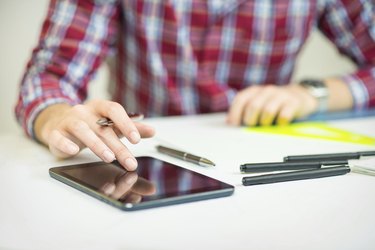
Apple designed the iPad and their other touch screen devices to excel at reading the touch of the human hand, so the company doesn't promote the use of a stylus. Nonetheless, many people who want to take hand notes or draw have demanded one, so other companies have produced them. These styluses are designed to function on Apple's patented touch screen.
Components of an Apple Touch Screen
Video of the Day
Apple devices like the iPad use what are called "capacitive" touch screens, meaning that they detect electrical current from the human body to operate. The glass screen covers a transparent conductive layer that contains capacitors, or small sensors, arranged in a coordinate system that recognize changes in electrical current. Underneath the conductive layer is the LCD display that you see when you use the iPad.
Video of the Day
How the Touch Screen Works
When you touch the iPad's screen, the capacitors pick up the electrical current signals from your hand. Every point on the capacitor grid generates an electrical impulse signal when the screen is touched and communicates touch-location data with the device's processor. Then the visual display responds accordingly. Since capacitative technology relies on electrical currents, touches other than a bare human hand won't work on an Apple touch screen.
How a Stylus Works With iPad's Touch Screen
For a stylus to work on the iPad's touch screen, it must conduct the electrical current from your hand to the device. To do this it must be constructed from conductive material like metal. Most models have a soft material like conductive foam at the tip, making the writing smoother and less likely to scratch the screen's surface. Since Apple's touch screen technology only reads electrical currents and not pressure, you won't be able to use touch sensitivity in your sketches, notes or drawings, although some apps claim to mimic it.
Stylus Models and Apps
Demand for an iPad stylus has resulted in third parties producing a variety of apps and styluses. While the basic technology behind all apps and styluses is the same, all of them contain slight differences that alter your experience. For example, some apps specialize in handwriting recognition, while others specialize in displaying fine lines and brush strokes. Likewise, styluses come in different shapes and sizes to better help you mimic drawing, sketching or writing.